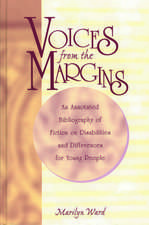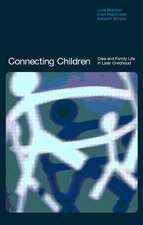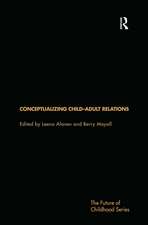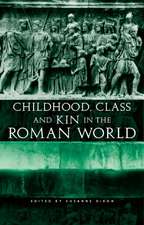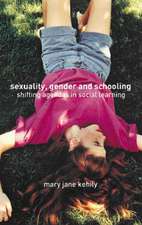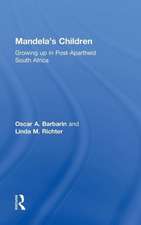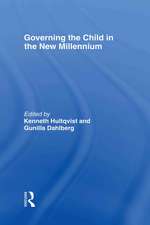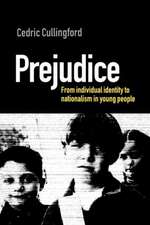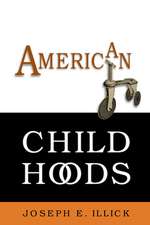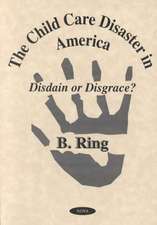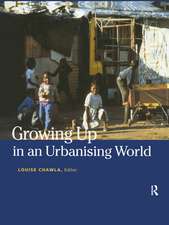Children and their Urban Environment: Changing Worlds
Autor Claire Freeman, Paul Tranteren Limba Engleză Paperback – 14 oct 2024
The authors highlight the importance of planners, architects and housing professionals in creating positive environments for children and involving them in the planning process. They argue that children's lives are becoming simultaneously both richer and more deprived, and that, despite apparently increasing wealth, disparities between children are increasing further. Each chapter includes international examples of good practice and policy innovations for redressing the balance in favour of child supportive environments. The book seeks to embrace childhood as a time of freedom, social engagement and environmental adventure and to encourage creation of environments that better meet the needs of children. The authors argue that in doing so, we will build more sustainable neighbourhoods, cities and societies for the future.
| Toate formatele și edițiile | Preț | Express |
|---|---|---|
| Paperback (1) | 217.63 lei 6-8 săpt. | |
| Taylor & Francis – 14 oct 2024 | 217.63 lei 6-8 săpt. | |
| Hardback (1) | 773.20 lei 6-8 săpt. | |
| Taylor & Francis – 30 mar 2011 | 773.20 lei 6-8 săpt. |
Preț: 217.63 lei
Preț vechi: 246.69 lei
-12% Nou
Puncte Express: 326
Preț estimativ în valută:
41.65€ • 45.22$ • 34.98£
41.65€ • 45.22$ • 34.98£
Carte tipărită la comandă
Livrare economică 22 aprilie-06 mai
Preluare comenzi: 021 569.72.76
Specificații
ISBN-13: 9781032923468
ISBN-10: 1032923466
Pagini: 284
Dimensiuni: 189 x 246 mm
Greutate: 0.53 kg
Ediția:1
Editura: Taylor & Francis
Colecția Routledge
Locul publicării:Oxford, United Kingdom
ISBN-10: 1032923466
Pagini: 284
Dimensiuni: 189 x 246 mm
Greutate: 0.53 kg
Ediția:1
Editura: Taylor & Francis
Colecția Routledge
Locul publicării:Oxford, United Kingdom
Public țintă
Academic and Professional Practice & DevelopmentCuprins
Part 1: Changing Environments, Changing Lives 1. Children's life worlds: Adapting to Physical and Social Change 2. Same World – Different World Part 2: Activity Spaces 3. Home 4. School 5. Neighbourhood 6. City Centre 7. Service Space 8. Cultural Space 9. Natural Space Part 3: Making a Difference: Creating Positive Environments for Children 10. Accessing Space: Mobility 11. Design 12. Professionals and Children: Working Together 13. Conclusion: Children's Play and Resilient Cities
Notă biografică
Claire Freeman is Associate Professor at the Department of Geography, University of Otago, New Zealand. Paul Tranter is Associate Professor in Geography at the University of New South Wales, Australian Defence Force Academy, Canberra, Australia.
Recenzii
"It is hard to do justice to this book in a short review but in conclusion, this is a wellcrafted and a competent piece of work, in terms of both its content and organisation. It is engagingly written and presented and examples of children’s own artwork are used particularly well to illustrate ‘good places for children’, such as museums and city centres." – Susan Pringle, School of Geography and Geosciences, University of St Andrews
"References set out at the end of each chapter enable the reader to take particular topics further than the book length would allow; the content is well- indexed and a full table of acronyms and abbreviations is provided." – Susan Pringle, School of Geography and Geosciences, University of St Andrews
'This book provides a powerful metaphor for professionals involved in developing the built environment.' – Neil Savery, National President, Planning Institute of Australia
'This irresistible book by Freeman and Tranter provides many valuable insights on ways to improve our future by making cities child-friendly, and thus more sustainable and resilient for everyone.' – Professor John Pucher, Rutgers University, USA
'This provocative book takes on the question parents, educators and, indeed, anyone concerned about the human future should be contemplating: how can we foster resilience and creativity so today's children can live well through a century of deep change and challenges we can hardly begin to imagine?' – Dianne Dumanoski, author of The End of the Long Summer, co-author of Our Stolen Future
'It always seems like the most inviting neighbourhoods are the ones where kids are outside, playing, walking or even running errands. It means the place is safe and welcoming, and that's good for folks of all ages. Here's to a book that brings this priority to city planning!' – Lenore Skenazy, author of the Free-Range Kids book and blog
'This book puts children at the centre of things. It demonstrates that if professionals, politicians, urban designers and those responsible for the spaces that children inhabit actually look at things through children's eyes we can visualize and operationalize dramatic improvements in the quality of life for everyone. This is an important achievement. We now have no excuse for delaying the task of making cities child friendly and, in the process, sorting out climate change, peak oil, energy security and resilience. We can also make our cities more joyful, enjoy nature rather than attack it and just have fun.'
– Professor John Whitelegg, Stockholm Environment Institute
'Advocates for children and child-friendly communities will be delighted to have this comprehensive book as a guide and reference. Thank you for giving children a voice in this seminal work.' – Catherine O'Brien, Cape Breton University
'More than just a litany of crises and problems facing children in today's urban environments, Freeman and Tranter set out a broad and evidenced-based agenda for social and cultural change. International in its scope, this book would be a marvelous addition to a wide variety of undergraduate and graduate courses across the social sciences – a must-read for professional urban planners and policy-makers.' – Mark Lowes, Associate Professor, Department of Communication, University of Ottawa
'As both a father and a researcher, I know how important the urban environment is to children as they progress into adulthood. This book, which is both readable and of high academic quality, will help readers understand the importance of good urban environments in developing our future generations.' – Associate Professor Simon Kingham, Head of Geography, University of Canterbury, New Zealand
"Children and Their Urban Environment is a timely and bracing wake-up call to a world
that has forgotten what makes children tick. By marshalling inspiring examples from around the world, Freeman and Tranter show us how to create urban settings where everyone, especially children, can thrive. If we heed their call, future generations will thank us – and them!’ - Carl Honoré, author of In Praise of Slow and Under Pressure
‘Clear-sighted, persuasive, accessible and borne of deep moral conviction – this comprehensive overview is shot through with insight and good sense. Anyone interested in resilient children, resilient cities and why the two are so closely linked should read it.’ - Tim Gill, author of No Fear: Growing Up in a Risk Averse Society
'This book presents evidence on how the interests of children need neither collide nor be subservient to those of other citizens, and how children and adults can bring about more sustainable and healthier communities. The authors demonstrate that space at various scales, need not be associated with practices of exclusion but can provide opportunities that include support and nurture the well being of children.' - Lonaard Magazine, Issue 12, Vol. 2, November 2012
"Whether you are a professional, a decision maker or a parent wanting to know more, or if you are simply interested in learning how we can better create spaces and societies that help our children and young people to develop into resilient, capable, adaptable adults, I would strongly recommend you add this book to your personal or organisational library. Children and Their Urban Environment - Changing Worlds reminds the reader that our children are the future and that why the design of our cities and towns must change to better cater for their unique needs and inherent desires." – Rolf Fenner, Australian Planner
"References set out at the end of each chapter enable the reader to take particular topics further than the book length would allow; the content is well- indexed and a full table of acronyms and abbreviations is provided." – Susan Pringle, School of Geography and Geosciences, University of St Andrews
'This book provides a powerful metaphor for professionals involved in developing the built environment.' – Neil Savery, National President, Planning Institute of Australia
'This irresistible book by Freeman and Tranter provides many valuable insights on ways to improve our future by making cities child-friendly, and thus more sustainable and resilient for everyone.' – Professor John Pucher, Rutgers University, USA
'This provocative book takes on the question parents, educators and, indeed, anyone concerned about the human future should be contemplating: how can we foster resilience and creativity so today's children can live well through a century of deep change and challenges we can hardly begin to imagine?' – Dianne Dumanoski, author of The End of the Long Summer, co-author of Our Stolen Future
'It always seems like the most inviting neighbourhoods are the ones where kids are outside, playing, walking or even running errands. It means the place is safe and welcoming, and that's good for folks of all ages. Here's to a book that brings this priority to city planning!' – Lenore Skenazy, author of the Free-Range Kids book and blog
'This book puts children at the centre of things. It demonstrates that if professionals, politicians, urban designers and those responsible for the spaces that children inhabit actually look at things through children's eyes we can visualize and operationalize dramatic improvements in the quality of life for everyone. This is an important achievement. We now have no excuse for delaying the task of making cities child friendly and, in the process, sorting out climate change, peak oil, energy security and resilience. We can also make our cities more joyful, enjoy nature rather than attack it and just have fun.'
– Professor John Whitelegg, Stockholm Environment Institute
'Advocates for children and child-friendly communities will be delighted to have this comprehensive book as a guide and reference. Thank you for giving children a voice in this seminal work.' – Catherine O'Brien, Cape Breton University
'More than just a litany of crises and problems facing children in today's urban environments, Freeman and Tranter set out a broad and evidenced-based agenda for social and cultural change. International in its scope, this book would be a marvelous addition to a wide variety of undergraduate and graduate courses across the social sciences – a must-read for professional urban planners and policy-makers.' – Mark Lowes, Associate Professor, Department of Communication, University of Ottawa
'As both a father and a researcher, I know how important the urban environment is to children as they progress into adulthood. This book, which is both readable and of high academic quality, will help readers understand the importance of good urban environments in developing our future generations.' – Associate Professor Simon Kingham, Head of Geography, University of Canterbury, New Zealand
"Children and Their Urban Environment is a timely and bracing wake-up call to a world
that has forgotten what makes children tick. By marshalling inspiring examples from around the world, Freeman and Tranter show us how to create urban settings where everyone, especially children, can thrive. If we heed their call, future generations will thank us – and them!’ - Carl Honoré, author of In Praise of Slow and Under Pressure
‘Clear-sighted, persuasive, accessible and borne of deep moral conviction – this comprehensive overview is shot through with insight and good sense. Anyone interested in resilient children, resilient cities and why the two are so closely linked should read it.’ - Tim Gill, author of No Fear: Growing Up in a Risk Averse Society
'This book presents evidence on how the interests of children need neither collide nor be subservient to those of other citizens, and how children and adults can bring about more sustainable and healthier communities. The authors demonstrate that space at various scales, need not be associated with practices of exclusion but can provide opportunities that include support and nurture the well being of children.' - Lonaard Magazine, Issue 12, Vol. 2, November 2012
"Whether you are a professional, a decision maker or a parent wanting to know more, or if you are simply interested in learning how we can better create spaces and societies that help our children and young people to develop into resilient, capable, adaptable adults, I would strongly recommend you add this book to your personal or organisational library. Children and Their Urban Environment - Changing Worlds reminds the reader that our children are the future and that why the design of our cities and towns must change to better cater for their unique needs and inherent desires." – Rolf Fenner, Australian Planner


